
County Antrim is one of the six counties of Northern Ireland, located within the historic province of Ulster. Adjoined to the north-east shore of Lough Neagh, the county covers an area of 3,086 square kilometres (1,192 sq mi) and has a population of 651,321, as of the 2021 census. County Antrim has a population density of 211 people per square kilometre or 546 people per square mile. It is also one of the thirty-two traditional counties of Ireland.
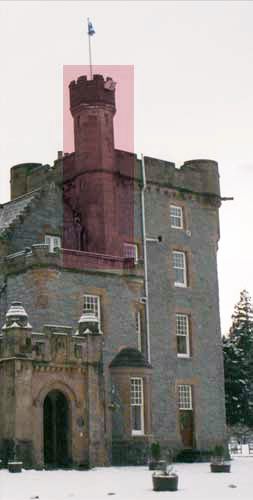
In architecture, a turret is a small tower that projects vertically from the wall of a building such as a medieval castle. Turrets were used to provide a projecting defensive position allowing covering fire to the adjacent wall in the days of military fortification. As their military use faded, turrets were used for decorative purposes, as in the Scottish baronial style.

Antrim is a town and civil parish in County Antrim in the northeast of Northern Ireland, on the banks of the Six Mile Water, on the northeast shore of Lough Neagh. It had a population of 25,606 people in the 2021 Census. It is the county town of County Antrim and was the administrative centre of Antrim Borough Council until its 2015 merger with Newtownabbey Borough Council. It is 22 miles (35 km) northwest of Belfast.

Ballygally or Ballygalley is a village and holiday resort in County Antrim, Northern Ireland which lies on the Antrim coast, approximately 3 miles north of Larne. It is also a townland of 769 acres and is situated in the civil parish of Carncastle and the historic barony of Glenarm Upper. It had a population of 821 in the 2011 Census. It is located within the Mid and East Antrim Borough Council area.
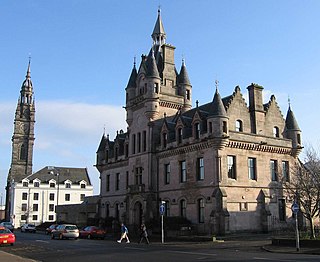
Scottish baronial or Scots baronial is an architectural style of 19th-century Gothic Revival which revived the forms and ornaments of historical architecture of Scotland in the Late Middle Ages and the Early Modern Period. Reminiscent of Scottish castles, buildings in the Scots baronial style are characterised by elaborate rooflines embellished with conical roofs, tourelles, and battlements with machicolations, often with an asymmetric plan. Popular during the fashion for Romanticism and the Picturesque, Scots baronial architecture was equivalent to the Jacobethan Revival of 19th-century England, and likewise revived the Late Gothic appearance of the fortified domestic architecture of the elites in the Late Middle Ages and the architecture of the Jacobean era.

Scrabo Tower is a 135 feet (41 m) high 19th-century lookout tower or folly that stands on Scrabo Hill near Newtownards in County Down, Northern Ireland. It provides wide views and is a landmark that can be seen from afar. It was built as a memorial to Charles Vane, 3rd Marquess of Londonderry and was originally known as the Londonderry Monument. Its architectural style is Scottish Baronial Revival.

Killyleagh Castle is a castle in the village of Killyleagh, County Down, Northern Ireland. It is believed to be amongst one of the oldest inhabited castles in the country, with parts dating back to 1180. It follows the architectural style of a Loire Valley château, being redesigned by the architect Sir Charles Lanyon in the mid-19th century. It has been owned by the Hamilton family since the early 17th century.

Castle Upton is situated in the village of Templepatrick, in County Antrim, Northern Ireland. It is around 12 miles (19 km) north-west of Belfast. Originally the site of a 13th-century fortified priory of the Knights of St John, the present building was constructed around 1610 by the Norton family who settled here during the Plantation of Ulster. Soon after, it was bought by the Upton family, later the Viscounts Templetown, who remained in possession until the 20th century. The castle was remodelled in the 1780s to designs by Robert Adam, who also designed the stable block now known as 'Adam Yard'. Upton was purchased in 1963 by Sir Robin Kinahan and Coralie de Burgh, by which time it was in a poor state of repair. Following restoration the Adam Yard was converted to housing, and the castle later opened as a wedding venue. In 2016 the property was placed on the market by Kinahan's son Danny Kinahan MP. The property is now owned by the Hughes family.

Parke's Castle is a 17th century semi-fortified manor house, situated on the northeast shore of Lough Gill, in the north of County Leitrim, in the western province of Connacht, Ireland. The castle is built on the site of an earlier sixteenth-century O'Rourke Gaelic tower house. The castle and bawn had come into the possession of Robert Parke by 1628, possibly earlier. He had been granted some of the former O'Rourke lands as part of the Plantations. By 1635, Parke had completed his fortified manor house on the site of the older Gaelic castle.

Lough Eske or Lough Eask is a small lake in County Donegal, Ireland. The lake lies to the northeast of Donegal Town, to which it is connected by the River Eske. The lake is about 900 acres (3.6 km2) in size and is surrounded to the north, east and west by the Bluestack Mountains, which occupy much of southern County Donegal.

Antrim Castle or Massereene Castle was a fortified mansion in Antrim, County Antrim, Northern Ireland, on the banks of the Sixmilewater River. It was built in stages between 1613 and 1662. It was destroyed by fire in 1922 and finally demolished in the 1970s. All that remains are a slightly raised grassed platform as well as a freestanding Italian stair tower built in 1887, and a gatehouse built around 1818 with twin neo-Tudor towers, with older connecting walls. The gardens are a popular tourist attraction on Randalstown Road, Antrim.

Trauma Towers, formerly The Haunted Hotel, was a themed funhouse, haunted attraction based at Blackpool Pleasure Beach in the North of the United Kingdom.

Helen's Tower is a 19th-century folly and lookout tower in Conlig, County Down, Northern Ireland. It was built by the 5th Lord Dufferin and Clandeboye and named for his mother, Helen. He intended it as a shrine for poems, first of all a poem by his mother and then other poems that he solicited from famous poets over the years. Tennyson's Helen's Tower is the best known of them. The tower is a fine example of Scottish Baronial architecture. Helen's Tower inspired the design of the Ulster Tower, a war memorial at Thiepval, France.
Crom Castle is a country house on the shores of Upper Lough Erne in County Fermanagh, Northern Ireland, the seat of the Earls Erne. Standing within the 1,900-acre (7.7 km2) Crom Estate, and within a formal garden, the castle is built in stone. A central battlemented tower includes the main entrance, and there are also smaller towers to one side. It stands apart from the ruins of Old Crom Castle, of which two towers, some walls, and a ha-ha survive, and near them two ancient yew trees, believed to be at least 800 years old.
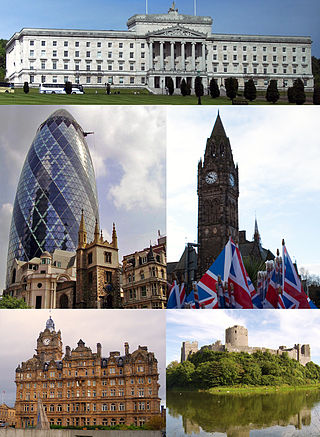
The architecture of the United Kingdom, or British architecture, consists of a combination of architectural styles, dating as far back to Roman architecture, to the present day 21st century contemporary. England has seen the most influential developments, though Ireland, Scotland, and Wales have each fostered unique styles and played leading roles in the international history of architecture. Although there are prehistoric and classical structures in the United Kingdom, British architectural history effectively begins with the first Anglo-Saxon Christian churches, built soon after Augustine of Canterbury arrived in Great Britain in 597. Norman architecture was built on a vast scale throughout Great Britain and Ireland from the 11th century onwards in the form of castles and churches to help impose Norman authority upon their dominions. English Gothic architecture, which flourished between 1180 until around 1520, was initially imported from France, but quickly developed its own unique qualities.

There are a number of reportedly haunted locations in Scotland.

Gurteen de la Poer, or Gurteen le Poer, is an Elizabethan Revival house in County Waterford, Ireland, situated on the south bank of the River Suir, close to Kilsheelan and about 8 km east of Clonmel.
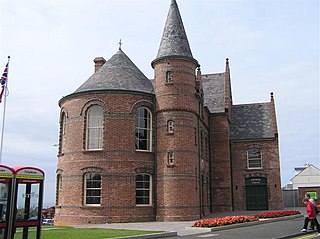
Portrush Town Hall is a municipal structure in Mark Street, Portrush, County Antrim, Northern Ireland. The structure, which is used as an events venue, is a Grade B+ listed building.
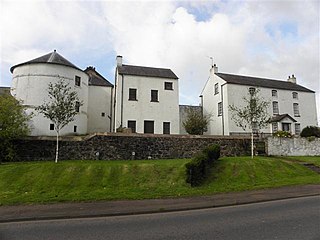
Bellaghy Bawn is a fortified house and bawn in Bellaghy, County Londonderry, Northern Ireland.
























